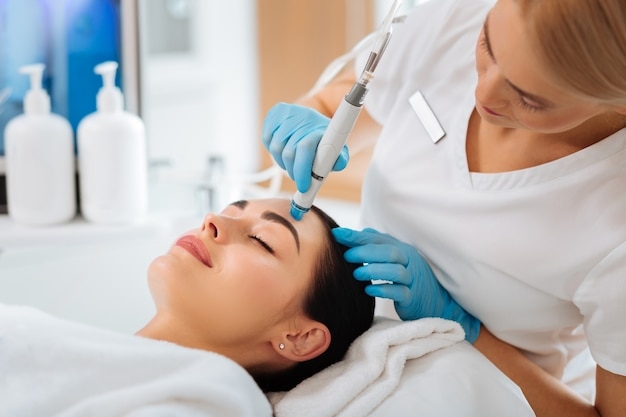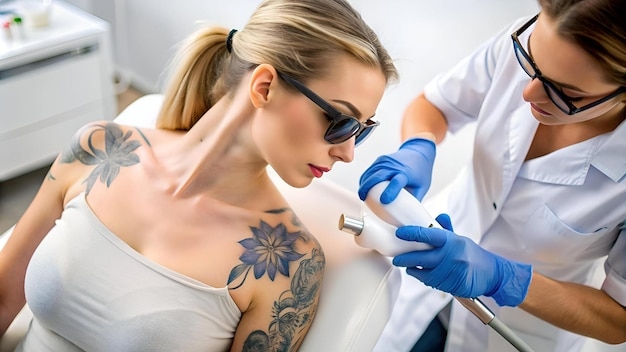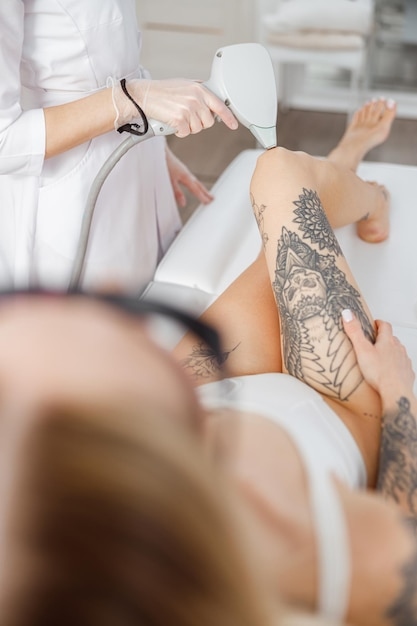 Content Gap Analysis – Find What Competitors Are Missing!
Content Gap Analysis – Find What Competitors Are Missing!
Maintaining Skin Health After Laser Tattoo Removal
Written by Dynamic Clinic » Updated on: June 17th, 2025

Laser tattoo removal is an effective method for eliminating unwanted tattoos, but it’s essential to care for your skin during the healing process. Proper aftercare not only promotes optimal healing but also helps maintain skin health and minimize potential complications. This article explores key strategies for maintaining skin health after Laser Tattoo Removal in Dubai, offering practical tips and advice to ensure your skin looks and feels its best.
Understanding the Healing Process
After laser tattoo removal, your skin will go through several healing stages. Immediately following the procedure, you may experience:
Redness and Swelling: Common responses to laser treatment, typically subsiding within a few hours to days.
Blistering and Scabbing: As the body begins to heal, blisters may form and scabs may develop over the treated area.
Itching and Peeling: These sensations are part of the healing process as your skin regenerates.
Understanding these stages can help you set realistic expectations and respond appropriately as your skin heals.
Key Aftercare Tips
1. Follow Your Practitioner’s Instructions
Your tattoo removal practitioner will provide specific aftercare instructions tailored to your skin type and the laser technology used. It’s crucial to follow these recommendations closely, as they are designed to optimize healing and minimize complications. Typical instructions may include:
Keeping the area clean and dry.
Applying prescribed ointments or creams.
Avoiding direct sunlight on the treated area.
2. Keep the Area Clean
Maintaining cleanliness is vital for preventing infection and promoting healing. Here’s how to care for the treated area:
Gentle Cleansing: Use a mild, fragrance-free soap to clean the area. Avoid scrubbing or using harsh cleansers that can irritate the skin.
Pat Dry: After washing, gently pat the area dry with a clean towel. Avoid rubbing, as this can cause irritation.
3. Moisturize Regularly
Keeping the skin hydrated is crucial for healing. Moisturizers can help soothe the skin, reduce itching, and support the regeneration process. Here are some tips:
Choose the Right Products: Opt for fragrance-free, hypoallergenic moisturizers or healing ointments recommended by your practitioner.
Apply Sparingly: Use a thin layer of moisturizer on the treated area, being careful not to over-saturate it.
4. Avoid Picking or Scratching
As the skin heals, it may itch or peel, which can be tempting to scratch or pick at. However, doing so can lead to complications such as:
Scarring: Picking at scabs can disrupt the healing process and increase the risk of scarring.
Infection: Scratching can introduce bacteria into the healing skin, leading to infections.
To manage itching, consider:
Cold Compresses: Applying a clean, cold compress can soothe itching without disrupting the healing process.
Gentle Tapping: Instead of scratching, gently tapping the area can help alleviate the urge to scratch.
5. Protect from Sun Exposure
Sun exposure can cause hyperpigmentation and damage to healing skin, making sun protection a critical aspect of aftercare. Here’s how to protect your skin:
Use Sunscreen: Apply a broad-spectrum sunscreen (SPF 30 or higher) to the treated area before going outside. Ensure it is water-resistant and fragrance-free.
Wear Protective Clothing: If possible, cover the area with loose, breathable clothing to shield it from the sun.
Avoid Tanning Beds: Stay away from tanning beds and excessive sun exposure during the healing phase.
6. Stay Hydrated
Proper hydration supports overall skin health and aids the healing process. Drinking plenty of water helps maintain skin elasticity and resilience. Aim for at least eight 8-ounce glasses of water a day, adjusting based on activity level and climate.
7. Maintain a Healthy Diet
A balanced diet rich in vitamins and minerals can enhance your skin’s healing capabilities. Consider including the following nutrients:
Vitamin C: Essential for collagen production and skin repair. Include citrus fruits, strawberries, and leafy greens in your diet.
Vitamin E: Known for its antioxidant properties, it helps protect the skin. Nuts, seeds, and avocados are excellent sources.
Zinc: Plays a role in wound healing. Incorporate foods like legumes, seeds, and whole grains.
Omega-3 Fatty Acids: Found in fatty fish, walnuts, and flaxseeds, omega-3s help reduce inflammation.
8. Monitor for Signs of Complications
Being vigilant about your skin’s healing process is essential. Keep an eye out for any unusual symptoms, such as:
Increased Redness or Swelling: While some redness and swelling are normal, significant increases may indicate infection or complications.
Discharge or Pus: Any discharge that is yellow or greenish in color may signal an infection.
Fever or Unusual Pain: If you experience systemic symptoms like fever or severe pain, consult your practitioner immediately.
If you notice any of these signs, don’t hesitate to reach out to your tattoo removal specialist for guidance.
9. Be Patient
Healing is a gradual process, and patience is key. Depending on the size and color of the tattoo, as well as individual skin type and healing ability, complete recovery can take several weeks. Here are some ways to stay patient:
Track Progress: Take photos of the treated area at intervals to visually track your healing journey. This can help you appreciate the progress made over time.
Stay Occupied: Engaging in activities you enjoy can help distract you from any impatience or anxiety about the healing process.
Long-Term Skin Care
Once your skin has healed completely, consider these long-term care strategies to maintain skin health and appearance:
1. Continue Sun Protection
Even after healing, the treated area may remain more sensitive to sun exposure. Continued sun protection is crucial to prevent pigmentation changes and maintain an even skin tone.
2. Establish a Skincare Routine
A consistent skincare routine can support overall skin health:
Gentle Cleansing: Cleanse your skin daily with mild, hydrating cleansers.
Moisturizing: Use a moisturizer suitable for your skin type to maintain hydration and elasticity.
Exfoliation: Once fully healed, gentle exfoliation can help remove dead skin cells and promote cell turnover. Avoid aggressive scrubs and opt for chemical exfoliants instead.
3. Stay Informed About Future Treatments
If you’re considering further laser sessions or other cosmetic treatments, stay informed about the best practices and protocols for maintaining skin health. Discuss options with your practitioner to ensure a comprehensive approach to your skincare.
4. Regular Dermatologist Visits
Consider scheduling regular visits with a dermatologist to monitor your skin health. They can provide personalized advice based on your skin type and any specific concerns.
Conclusion
Maintaining skin health after laser tattoo removal is essential for achieving the best possible results and ensuring a smooth healing process. By following these aftercare tips, staying informed, and being proactive about your skincare routine, you can support your skin's recovery and overall health. Remember, patience and consistent care are key to enjoying the benefits of your tattoo removal experience. With the right approach, you can look forward to fresh, healthy skin and a new chapter in your life.
Note: IndiBlogHub features both user-submitted and editorial content. We do not verify third-party contributions. Read our Disclaimer and Privacy Policyfor details.
Men's Journal is a rugged and refined lifestyle adventure travel, food and drink Get in touch [email protected] to find out how we can help you reach everyday, affluent, and adventure seeking consumers on Men's Journal
Copyright © 2019-2025 IndiBlogHub.com. All rights reserved. Hosted on DigitalOcean for fast, reliable performance.












